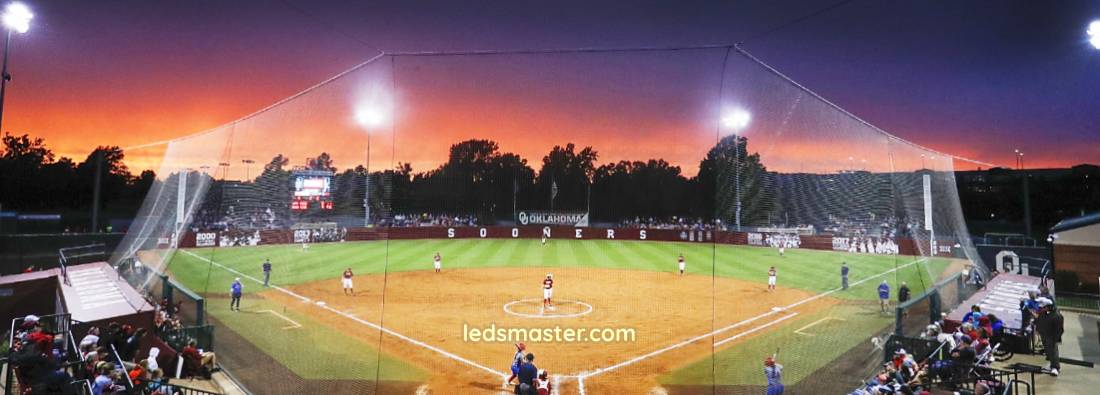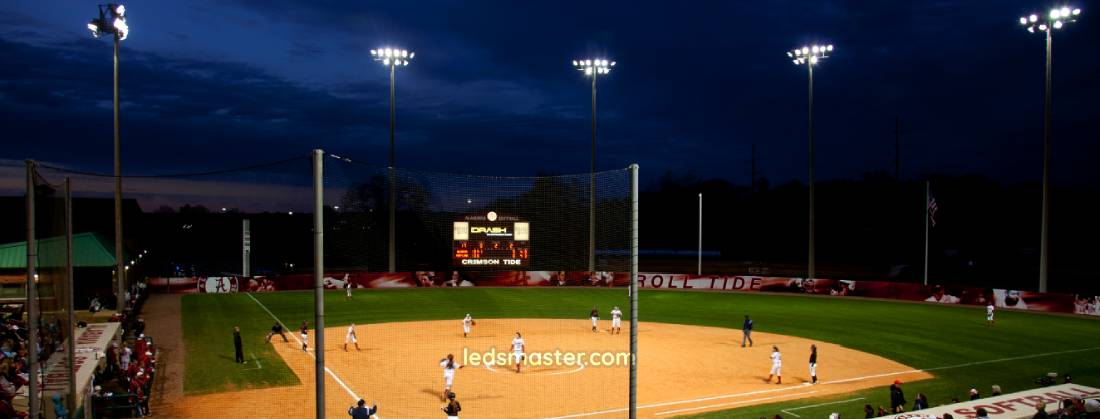Lighting a softball field is more than just an investment in visibility—it’s about enhancing player safety, ensuring a professional-level atmosphere, and meeting regulatory standards. The cost of installing or upgrading field lighting can vary widely, driven by several key factors such as the number of lights, poles, and the type of lighting technology.
Get your complimentary lighting design today
Proper field lighting allows for games to be played after dark and ensures consistent playability regardless of weather conditions. However, the cost of lighting a softball field can vary significantly, depending on a variety of factors. This article will explore the costs associated with softball field lighting, the elements that impact those costs, ways to save money, and the reasons for lighting replacements.
| Cost Category | Description | Estimated Range |
|---|---|---|
| Light Cost | Cost of purchasing LED or metal halide lights for the field (typically 4-8 poles). | $30,000 – $80,000 |
| Installation Cost | Labor and materials for installing lighting poles, electrical wiring, and fixtures. | $20,000 – $50,000 |
| Running Cost (Electricity) | Monthly energy consumption based on usage (LED lights are more energy-efficient than traditional ones). | $500 – $1,500 per month |
| Maintenance Cost | Annual maintenance including bulb replacement, cleaning, and fixture repair. | $1,000 – $3,000 per year |
| Control System Cost | Optional cost for advanced lighting control systems (timers, dimming features, etc.). | $5,000 – $15,000 |
| Total Initial Investment | Total upfront cost including lights, installation, and control systems. | $55,000 – $145,000 |
Table of Contents
ToggleThe cost of lighting a softball field is influenced by a wide range of factors. From the number of lights to the design of the field itself, each component contributes to the overall expense. Below, we’ll take a closer look at the primary factors that impact the cost.
One of the most significant factors affecting the cost of lighting a softball field is the number of lights required. The larger the field, the more lights will be necessary to provide sufficient illumination. A standard softball field typically requires between 4 and 8 lighting poles, with multiple light fixtures on each pole. The number of fixtures depends on the level of competition being played on the field and the requirements for brightness and uniformity.
Higher-level competitions, such as college or professional games, require brighter and more uniform lighting, which will increase the number of light fixtures. The cost of each light fixture can vary depending on the type and quality of lighting used.
The number of poles is another major factor in determining the cost. Most softball fields require four to eight poles to properly illuminate the field. Poles are strategically placed around the field to ensure that the lighting is evenly distributed and minimizes shadows that could interfere with player visibility.
The taller the poles, the more expensive they will be. Taller poles are often necessary for fields with stricter lighting standards, such as those used for televised games or larger competitions. Additionally, poles with advanced features, such as anti-corrosion coatings or wind resistance designs, can add to the overall cost.

The type of lighting technology used is another critical factor. Traditional metal halide lights were once the standard for sports field lighting, but modern LED lighting has become increasingly popular. LED lights, while more expensive upfront, are far more energy-efficient and have a longer lifespan than metal halide lights. Over time, LED lights can save considerable money in terms of electricity usage and maintenance costs.
Although LED lighting systems come with a higher initial cost, their durability and energy efficiency make them the better long-term investment. They require less maintenance, reduce energy consumption by up to 50%, and have a lifespan that can exceed 50,000 hours.
The dimensions of the softball field will affect the cost of lighting. A regulation softball field has specific measurements for the outfield, infield, and base paths, but the dimensions may vary depending on the league or level of play. Larger fields will require more lighting fixtures and taller poles to ensure the entire playing area is well-lit.
Additionally, the layout of the field, including any nearby structures or obstructions, can affect the installation of lighting. Fields located near residential areas may need special lighting designs to reduce light spill and glare, which can add to the overall expense.
While lighting a softball field can be a significant investment, there are ways to reduce costs without sacrificing quality. By carefully considering certain aspects of the installation, you can save money both upfront and over the long term.
One of the most effective ways to save money on lighting is to invest in energy-efficient LED lights. Although the initial cost is higher compared to traditional lighting systems, LED lights offer substantial energy savings, which will reduce operating costs over time. Moreover, because LED lights have a longer lifespan, you will save money on maintenance and replacement costs in the future.

Another way to reduce costs is to optimize the number of poles used for the lighting system. By working with a professional lighting designer, you can ensure that the correct number of poles and fixtures are installed to provide adequate illumination without overspending. In some cases, fewer poles may be needed if you use higher-quality lights or carefully position the lighting system for maximum efficiency.
If your softball field already has an existing lighting system, retrofitting the lights with new, energy-efficient fixtures can be a more cost-effective solution than replacing the entire system. By upgrading the lighting technology, you can achieve better performance and energy savings without the high costs associated with installing new poles and wiring.
Lighting replacement is sometimes necessary due to the age of the existing system, changes in lighting standards, or the need for more energy-efficient technology. There are several reasons why a softball field may require lighting replacement.
Over time, traditional metal halide lighting systems can experience a decrease in performance due to bulb deterioration, corrosion of fixtures, or damage to wiring. When lighting quality declines, it can impact the safety and playability of the field. Replacing outdated lighting with modern LED technology can improve lighting uniformity, brightness, and reduce maintenance costs.
As energy costs rise, more facilities are choosing to replace their outdated lighting systems with energy-efficient LED lights. LED technology provides the same or better illumination while consuming significantly less electricity. The reduced energy consumption translates to lower utility bills, which can save field operators thousands of dollars annually.
Sports lighting standards are frequently updated to improve player safety and reduce light pollution. Fields that do not meet the required lighting levels may need to replace their existing system to comply with league or competition regulations. In addition, many municipalities have ordinances that limit light spill and glare to nearby areas, which may necessitate lighting upgrades or replacements.
In addition to the factors already mentioned, there are other costs associated with softball field lighting that should be considered. These additional costs can include installation fees, maintenance, and any special features required for the lighting system.
The cost of installing a lighting system for a softball field can vary depending on the complexity of the project. Installation typically includes wiring, foundation work for the poles, and positioning the fixtures for optimal lighting performance. Working with a professional lighting company is essential to ensure that the installation meets safety and performance standards.
Although modern LED lights require less maintenance than traditional lighting systems, they still need periodic inspections to ensure optimal performance. Over time, fixtures may need to be adjusted, cleaned, or replaced if they are damaged. Setting aside a maintenance budget is important to keep the lighting system running efficiently.
Some fields may require additional features for their lighting system, such as weather-resistant fixtures for outdoor environments or lights with adjustable brightness for different events. These special features can add to the overall cost of the system but may be necessary depending on the specific needs of the field.
The cost of lighting a softball field is influenced by a variety of factors, including the number of lights, the number of poles, the type of lighting technology, and the field’s dimensions. By investing in energy-efficient LED lights and optimizing the design of the lighting system, you can save money on both installation and long-term operational costs. Lighting replacement is often necessary to maintain safety, comply with regulations, and improve energy efficiency.
When planning a lighting system for your softball field, it’s essential to work with professionals who can help you design a system that meets your needs while staying within your budget. By understanding the factors that impact cost and exploring ways to save money, you can ensure that your softball field is well-lit and ready for play, day or night.